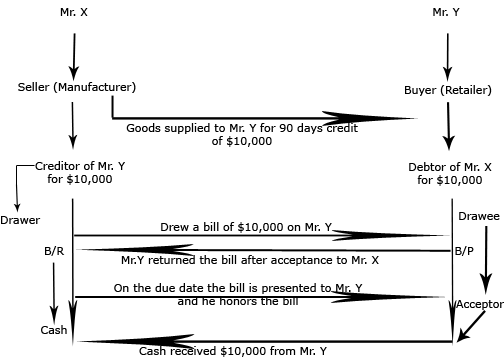|
In
business concerns, numerous bills of exchange are
drawn and accepted. Special journals are used to
record bills of exchange, called bill receivable
journal and bill payable journal. From these two
journals the totals are posted to bills receivable
account and bills payable account respectively.
Every
bill has two different aspects. To the drawer who
has sold goods and wants to be paid for them, it is
a bill receivable, he hopes to receive money on the
due date. Such bills are recorded in the bills
receivable journal. It is a sort of asset for the
drawer and as good as money. To the acceptor of the
bill, who has bought goods on credit and has agreed
to honor the bill on the due date, it is a bill
payable. The acceptor must arrange in due course the
funds available to honor the bill when it falls due.
Such bills are recorded in the bills payable
journal.
Explanation with an Example:
We can
understand the accounting of bills of exchange with
the help of an example. Let us suppose, Mr X is a
manufacturer of shoes and Mr. Y is a retail trader
of shoes. Mr. Y (the buyer) wishes to buy shoes from
the manufacturer but has no money. He is agreed to
accept a bill of exchange for 90 days, if goods are
sold to him on credit basis. So both the parties
agreed. Mr. X supplies goods to Mr. Y worth $10,000
for a 90 days credit and draws upon him a bill for
the full value of goods for 90 days on 1st Jan.
2005.
The
illustration given above can be summarized below:
|
Mr. X becomes
creditor and Mr. Y becomes debtor. |
 |
|
Acceptance
received from Mr. Y. |
There are three
transactions which have taken place:
- Mr. X sold
goods to Mr. Y worth $10,000 on credit basis.
- Mr. X drew a
bill of exchange on Mr. Y for 90 days for
$10,000.
- On the due
date the bill was presented to Mr. Y and he
honored the bill (met his obligation on the due
date)
Journal Entries:
Now we shall see
how these transactions are recorded in journal of
Mr. X and Mr. Y.
Mr. X's Journal
Transaction
No.1
Mr. X sold goods to
Mr. Y for $10,000 on credit. The journal entry is:
1st Jan.
2005 |
Y A/c
Dr.
Sales A/c
(Goods sold on credit) |
|
10,000 |
10,000 |
Transaction
No. 2
Mr. Y drew a bill
on Mr. X for 90 days. The journal entry is:
1st Jan.
2005 |
Bill
receivable A/c
Dr.
Y A/c
(Acceptance received from Mr. Y) |
|
10,000 |
10,000 |
Transaction
No. 3
On the due date
acceptor honors the bill. The journal entry is:
4 April.
2005 |
Cash/Bank A/c
Dr.
Bill receivable A/c
(Received cash on presentation of bill) |
|
10,000 |
10,000 |
Mr. Y's Journal
Transaction
No.1
Bought goods from
Mr. X for $ 10,000. The journal entry is:
1st Jan.
2005 |
Purchases A/c
Dr.
X A/c
(Goods purchased on credit) |
|
10,000 |
10,000 |
Transaction
No. 2
Acceptance given to
Mr. X instead of paying him cash. The journal entry
is:
1st Jan.
2005 |
X A/c
Dr.
Bill payable A/c
(Acceptance given to Mr. X) |
|
10,000 |
10,000 |
Transaction
No. 3
Acceptance is met
(paid of due date). The journal entry is:
4 April.
2005 |
Bill payable
A/c
Dr.
Cash A/c
(Acceptance is paid in cash) |
|
10,000 |
10,000 |
Different Uses of a Bill of Exchange:
In the above illustration, we just
discussed only one use of a bill of exchange
i.e., the drawer retained the bill with
himself till due date and then presented to
the acceptor, who honored the bill (paid
cash to the drawer). Every drawer or
receiver of a bill has three options for
him.
- He can retain the bill till the due date.
(As discussed above).
- He can send the bill to his bank for
collection. Bank will present the bill before
drawee on due date and will collect the amount
for drawer.
View accounting treatment for this option on "Bill of Exchange
Sent to Bank for Collection" page
- He can endorse the bill to one of his
creditors in settlement of his own debts.
View accounting treatment for this option on "Endorsement of Bill of Exchange"
page
- He can discount it with his bank if he is in
need of money and cannot wait till the due date.
View accounting treatment for this option on "Discounting of a Bill of Exchange"
page
In the same way every acceptor has four
possibilities.
- He may pay the amount of bill on
presentation. (As discussed above).
- He may refuse to honor the bill. It is
called dishonor of a bill of exchange. Read
Dishonor of Bill of Exchange
- He may request the drawer to renew the bill
(extending the period of payment). Read
Renewal of Bill of Exchange
- He may get the bill retired. (paying his
obligation before the due date). Read
Retiring
a Bill of Exchange Under Rebate.
|